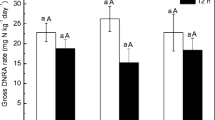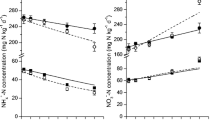Abstract
The rapid expansion of intensively farmed vegetable fields has substantially contributed to the total N2O emissions from croplands in China. However, to date, the mechanisms underlying this phenomenon have not been completely understood. To quantify the contributions of autotrophic nitrification, heterotrophic nitrification, and denitrification to N2O production from the intensive vegetable fields and to identify the affecting factors, a 15N tracing experiment was conducted using five soil samples collected from adjacent fields used for rice-wheat rotation system (WF), or for consecutive vegetable cultivation (VF) for 0.5 (VF1), 6 (VF2), 8 (VF3), and 10 (VF4) years. Soil was incubated under 50% water holding capacity (WHC) at 25°C for 96 h after being labeled with 15NH4NO3 or NH 154 NO3. The average N2O emission rate was 24.2 ng N kg−1 h−1 in WF soil, but it ranged from 69.6 to 507 ng N kg−1 h−1 in VF soils. Autotrophic nitrification, heterotrophic nitrification and denitrification accounted for 0.3–31.4%, 25.4–54.4% and 22.5–57.7% of the N2O emissions, respectively. When vegetable soils were moderately acidified (pH, 6.2 to ≥ 5.7), the increased N2O emissions resulted from the increase of both the gross autotrophic and heterotrophic nitrification rates and the N2O product ratio of autotrophic nitrification. However, once severe acidification occurred (as in VF4, pH ≤ 4.3) and salt stress increased, both autotrophic and heterotrophic nitrification rates were inhibited to levels similar to those of WF soil. The enhanced N2O product ratios of heterotrophic nitrification (4.84‰), autotrophic nitrification (0.93‰) and denitrification processes were the most important factors explaining high N2O emission in VF4 soil. Data from this study showed that various soil conditions (e.g., soil salinity and concentration of NO -3 or NH +4 ) could also significantly affect the sources and rates of N2O emission.







Similar content being viewed by others
References
Adviento-Borbe MAA, Doran JW, Drijber RA, Dobermann A (2006) Soil electrical conductivity and water content affect nitrous oxide and carbon dioxide emissions in intensively managed soils. J Environ Qual 35:1999–2010
Amos B, Arkebauer TJ, Doran JW (2005) Soil surface fluxes of greenhouse gases in an irrigated maize-based agroecosystem. Soil Sci Soc Am J 69:387–395
Beare MH, Gregorich EG, Georges PS (2009) Compaction effects on CO2 and N2O production during drying and rewetting of soil. Soil Biol Biochem 41:611–621
Bock E, Schmidt I, Stüven R, Zart D (1995) Nitrogen loss caused by denitrifying Nitrosomonas cells using ammonium or hydrogen as electron donors and nitrite as electron acceptor. Arch Microbiol 163:16–20
Cai ZC, Xing GX, Yan XY, Xu H, Tsuruta H, Yagi K, Minami K (1997) Methane and nitrous oxide emissions from rice paddy fields as affected by nitrogen fertilisers and water management. Plant Soil 196:7–14
Cao ZH, Huang JF, Zhang CS, Li AF (2004) Soil quality evolution after land use change from paddy soil to vegetable land. Environ Geochem Health 26:97–103
Dannenmann M, Butterbach-Bahl K, Gasche R, Willibald G, Papen H (2008) Dinitrogen emissions and the N2:N2O emission ratio of a Rendzic Leptosol as influenced by pH and forest thinning. Soil Biol Biochem 40:2317–2323
De Boer W, Kowalchuk GA (2001) Nitrification in acid soils: Micro-organisms and mechanisms. Soil Biol Biochem 33:853–866
FAO (Food Agriculture Organization of United Nations) (2008) FAO statistical databases. http://faostat.fao.org/default.aspx
Firestone MK, Davidson EA (1989) Microbiological basis of NO and N2O production and consumption in soil. In: Andreae MO, Schimel DS (eds) Exchange of trace gases between terrestrial ecosystems and the atmosphere. Wiley, New York, pp 7–21
Freney JR (1997) Emission of nitrous oxide from soils used for agriculture. Nutr Cycl Agroecosyst 49:1–6
Frijlink MJ, Abee T, Laanbroek HJ, De Boer W, Konings WN (1992) The bioenergetics of ammonia and hydroxylamine oxidation in Nitrosomonas europaea at acid and alkaline pH. Arch Microbiol 157:194–199
Habteselassie MY, Stark JM, Miller BE, Thacker SG, Norton JM (2006) Gross nitrogen transformations in an agricultural soil after repeated dairy-waste application. Soil Sci Soc Am J 70:1338–1348
Hayakawa A, Akiyama H, Sudo S, Yagi K (2009) N2O and NO emissions from Andisol field as influenced by pelleted poultry manure. Soil Biol Biochem 41:21–529
He FF, Jiang RF, Chen Q, Zhang FS, Su F (2009) Nitrous oxide emissions from an intensively managed greenhouse vegetable cropping system in Northern China. Environ Pollut 157:1666–1672
Honda N, Hirai M, Ano T, Shoda M (1998) Antifungal effect of a heterotrophic nitrifier Alcaligenes faecalis. Biotechnol Lett 20:703–705
IPCC (2007) In: Metz B, Davidson OR, Bosch PR, Dave R, Meyer LA (eds) Climate Change 2007: Mitigation. Contribution of Working Group III to the Fourth Assessment Report of the Intergovernmental Panel on Climate Change. Cambridge University Press, Cambridge, p 499
Jiang QQ, Bakken LR (1999) Nitrous oxide production and methane oxidation by different ammonia-oxidizing bacteria. Appl Environ Microbiol 65:2679–2684
Ju XT, Kou CL, Zhang FS, Christie P (2006) Nitrogen balance and groundwater nitrate contamination: comparison among three intensive cropping systems on the North China Plain. Environ Pollut 143:117–125
Kesik M, Blagodatski S, Papen H, Butterbach-Bahl K (2006) Effect of pH, temperature and substrate on N2O, NO and CO2 production by Alcaligenes faecalis p. J Appl Microbiol 101:655–667
Khalil K, Mary B, Renault C (2004) Nitrous oxide production by nitrification and denitrification in soil aggregates as affected by O2 concentration. Soil Biol Biochem 36:687–699
Laughlin RJ, Rütting T, Müller C, Watson CJ, Stevens RJ (2009) Effect of acetate on soil respiration, N2O emissions and gross N transformations related to fungi and bacteria in a grassland soil. Appl Soil Ecol 42:25–30
Lei BK, Fan MS, Chen Q, Six J, Zhang FS (2010) Conversion of wheat–maize to vegetable cropping systems changes soil organic matter characteristics. Soil Sci Soc Am J 74:1320–1326
Lin S, Iqbal J, Hu RG, Feng ML (2010) N2O emissions from different land uses in mid-subtropical China. Agric Ecosyst Environ 136:40–48
Lu RK (2000) Soil agro-chemical analyses. Agricultural Technical Press of China, Beijing (in Chinese)
Martikainen PJ (1985) Nitrous oxide emission associated with autotrophic ammonium oxidation in acid coniferous forest soil. Appl Environ Microbiol 50:1519–1525
Martikainen PJ, De Boer W (1993) Nitrous oxide production and nitrification in acidic soil from a Dutch coniferous forest. Soil Biol Biochem 25:343–347
Meng L, Ding WX, Cai ZC (2005) Long-term application of organic manure and nitrogen fertilizer on N2O emission, soil quality and crop productivity in a sandy loam soil. Soil Biol Biochem 37:2037–2045
Mørkved PT, Dorsch P, Bakken LR (2007) The N2O product ratio of nitrification and its dependence on long-term changes in soil pH. Soil Biol Biochem 39:2048–2057
Müller C, Martina M, Stevens RJ, Laughlin RJ, Kammann C, Ottowa JCG, Jäger HJ (2002) Processes leading to N2O emissions in grassland soil during freezing and thawing. Soil Biol Biochem 34:1325–1331
Müller C, Stevens RJ, Laughlin RJ, Jäger HJ (2004) 10th International Symposium on Microbial Ecology (ISME-10). Cancun, Mexico
Müller C, Rütting T, Kattge J, Laughlin RJ, Stevens RJ (2007) Estimation of parameters in complex 15N tracing models via Monte Carlo sampling. Soil Biol Biochem 39:715–726
National Bureau of Statistics of China (2008) China agriculture yearbook. China Agric Press, Beijing
Pang XB, Mu YJ, Lee XQ, Fang SX, Yuan J, Huang DK (2009) Nitric oxides and nitrous oxide fluxes from typical vegetables cropland in China: Effects of canopy, soil properties and field management. Atmos Environ 43:2571–2578
Papen H, von Berg R (1998) A most probable number method (MPN) for the estimation of cell numbers of heterotrophic nitrifying bacteria in soil. Plant Soil 199:123–130
Qiu SJ, Ju XT, Ingwersen J, Qin ZC, Li L, Streck T, Christie P, Zhang FS (2010) Changes in soil carbon and nitrogen pools after shifting from conventional cereal to greenhouse vegetable production. Soil Till Res 107:80–87
Renault P, Stengel P (1994) Modeling oxygen diffusion in aggregated soils. I. Anaerobiosis inside the aggregates. Soil Sci Soc Am J 58:1017–1023
Robertson LA, Kuenen JG (1984) Aerobic denitrification, a controversy revived. Arch Microbiol 139:351–354
Robertson LA, Cornelisse R, Vos PD, Hadioetomo R, Kuenen JG (1989) Aerobic denitrification in various heterotrophic nitrifiers. Anto Leeuw Int J G 56:289–299
Ruser R, Flessa H, Russow R, Schmidt G, Buegger F, Munch JC (2006) Emission of N2O, N2 and CO2 from soil fertilized with nitrate: Effect of compaction, soil moisture and rewetting. Soil Biol Biochem 38:263–274
Rütting T, Clough T, Müller C, Lieffering M, Newton PCD (2010) Ten years of elevated atmospheric carbon dioxide alters soil nitrogen transformations in a sheep-grazed pasture. Glob Change Biol 16:2530–2542
Schmidt I, Bock E (1997) Anaerobic ammonia oxidation with nitrogen dioxide by Nitrosomonas eutropha. Arch Microbiol 167:106–111
Shi WM, Yao J, Yan F (2009) Vegetable plantation under greenhouse conditions leads to rapid accumulation of nutrients, acidification and salinity of soils and groundwater contamination in South-Eastern China. Nutr Cycl Agroecosyst 83:73–84
Simek M, Cooper JE (2002) The influence of soil pH on denitrification: progress towards the understanding of this interaction over the last 50 years. Eur J Soil Sci 53:345–354
Skiba U, Smith KA, Fowler D (1993) Nitrification and denitrification as sources of nitric oxide and nitrous oxide in a sandy loam soil. Soil Biol Biochem 25:1527–1536
Stevens RJ, Laughlin RJ, Burns LC, Arah JRM, Hood RC (1997) Measuring the contributions of nitrification and denitrification to the flux of nitrous oxide from soil. Soil Biol Biochem 29:139–151
Stevens RJ, Laughlin RJ, Malone JP (1998) Soil pH affects reducing nitrate to nitrous oxide and di-nitrogen. Soil Biol Biochem 30:1119–1126
Tiedje JM, Firestone RB, Betlach MR, Smith MS, Caskey HW (1979) Methods for the production and use of nitrogen-13 in studies of denitrification. Soil Sci Soc Am J 43:709–716
Van Cleemput O, Samater AH (1996) Nitrite in soils: accumulation and role in the formation of gaseous N compounds. Fertil Res 45:81–89
Williams EJ, Hutchinson GL, Fehsenfeld FC (1992) NOx and N2O emissions from soil. Glob Biogeochem Cy 4:351–388
Xiong ZQ, Xie YX, Xing GX, Zhu ZL, Butenhoff C (2006) Measurements of nitrous oxide emissions from vegetable production in China. Atmos Environ 40:2225–2234
Xiong ZQ, Khalil MAK, Xing GX, Shearer MJ, Butenhoff C (2009) Isotopic signatures and concentration profiles of nitrous oxide in a rice-based ecosystem during the drained crop-growing season. J Geophys Res 114:G02012. doi:10.1029/2008JG000827
Xue D, Yao HY, Huang CY (2006) Microbial biomass, N mineralization and nitrification, enzyme activities, and microbial community diversity in tea orchard soils. Plant Soil 288:319–331
Yang LF, Cai ZC (2005) The effect of growing soybean (Glycine maxine L.) on N2O emission from soil. Soil Biol Biochem 37:1205–1209
Yin R, Zhang HY, Huang JF, Lin XG, Wan JH, Cao ZH (2004) Comparison of microbiological properties between soils of rice–wheat rotation and vegetable cultivation. Plant Nutr Fertil Sci 10:57–62 (in Chinese)
Zhang JB, Cai ZC, Cheng Y, Zhu TB (2009) Denitrification and total nitrogen gas production from forest soils of Eastern China. Soil Biol Biochem 41:2551–2557
Zheng XH, Han SH, Huang Y, Wang YS, Wang MX (2004) Re-quantifying the emission factors based on field measurements and estimating the direct N2O emission from Chinese croplands. Glob Biogeochem Cy 18:GB2018. doi:10.1029/2003GB002167
Zhong WH, Cai ZC, Zhang H (2007) Effects of long-term application of inorganic fertilizers on biochemical properties of a rice-planting red soil. Pedosphere 17:419–428
Acknowledgements
The project was financially supported by the Innovative Scholar Development Program of Jiangsu province (SBK20082282), the National Natural Science Foundation of China (40830531; 40921061) and Natural Science Foundation of Jiangsu Province (BK2010611). We sincerely appreciate Prof. C. Müller in Department of Plant Ecology, Justus-Liebig University Giessen, Germany, for help running 15N tracing model.
Author information
Authors and Affiliations
Corresponding author
Additional information
Responsible Editor: Klaus Butterbach-Bahl.
Rights and permissions
About this article
Cite this article
Zhu, T., Zhang, J. & Cai, Z. The contribution of nitrogen transformation processes to total N2O emissions from soils used for intensive vegetable cultivation. Plant Soil 343, 313–327 (2011). https://doi.org/10.1007/s11104-011-0720-3
Received:
Accepted:
Published:
Issue Date:
DOI: https://doi.org/10.1007/s11104-011-0720-3




